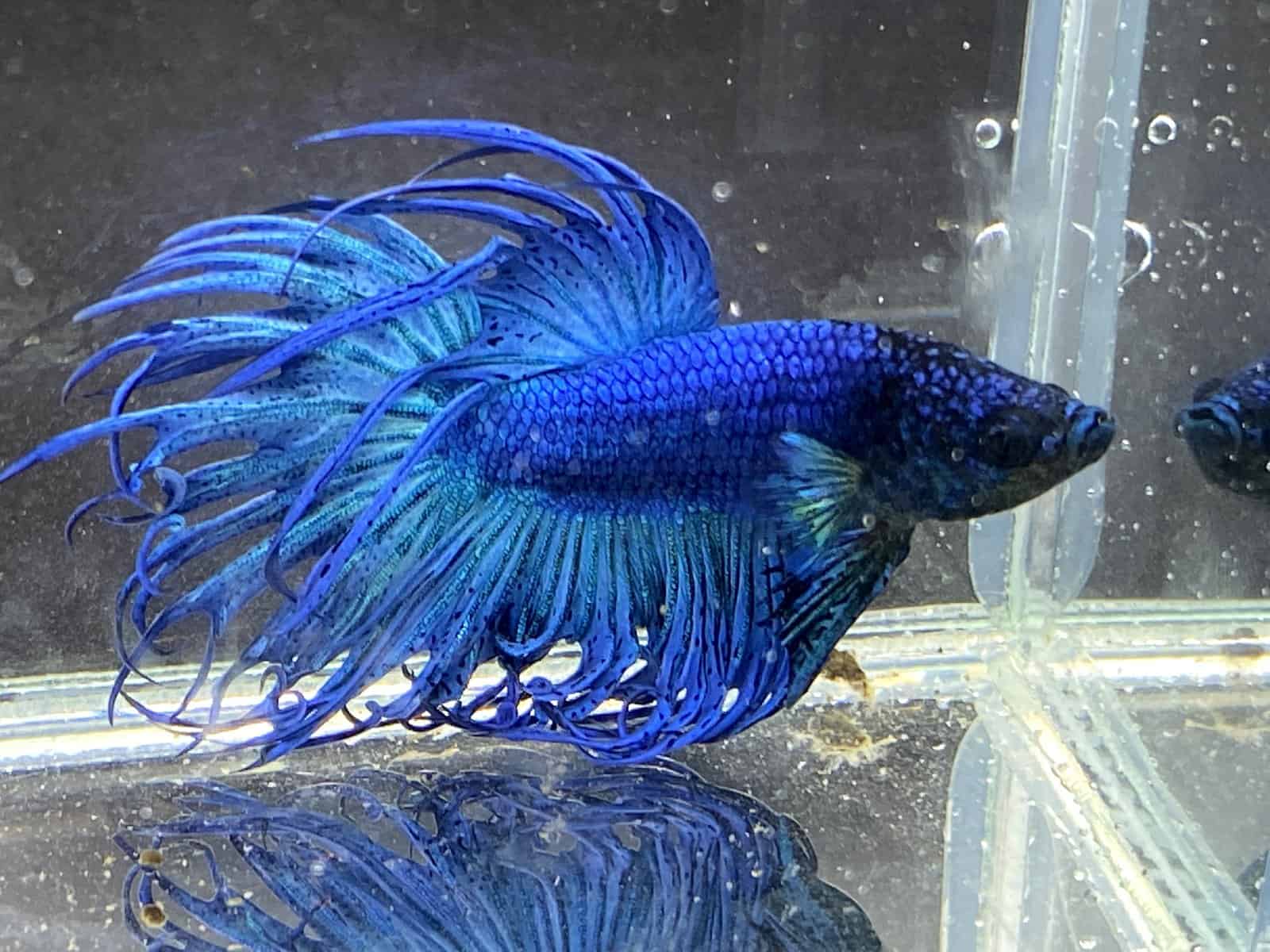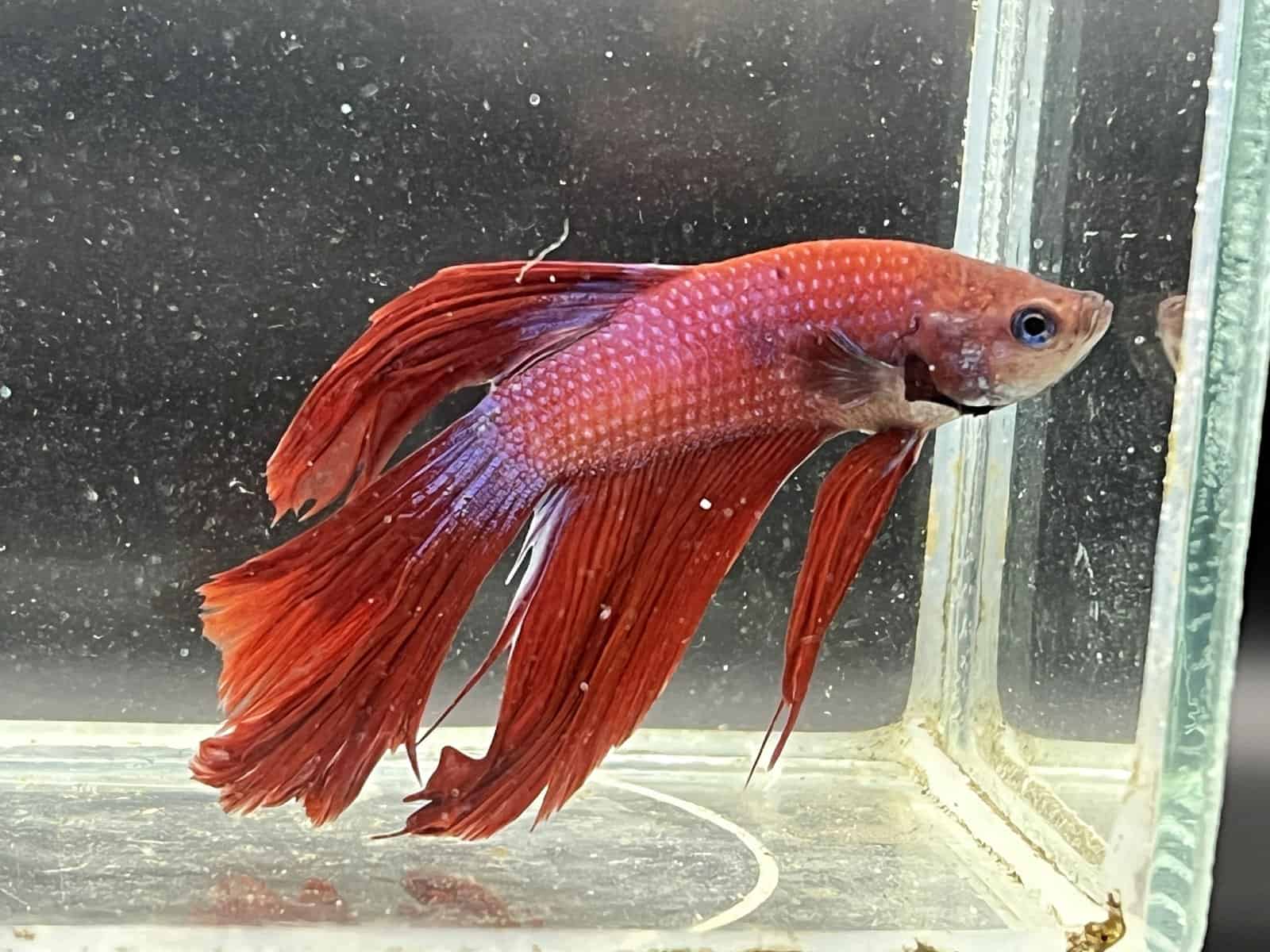So you’ve noticed black gills on your betta fish? That’s not unusual, and not necessarily a problem – although it could be.
What appears to be black gills in betta fish is usually not their gills at all, but a black ‘beard’, a normal and healthy part of their anatomy.
Occasionally, however, a betta’s gills really will turn purple or black from ammonia poisoning – a serious condition due to poor water conditions that demands immediate action to save your fish’s life.
Let’s take a closer look at those two issues.
Black Beard in Betta Fish
If your betta appears to have black gills but the rest of his body seems in good order, the chances are that you simply have a betta with a black beard.
Of course, this ‘beard’ is not really a beard at all, but a special membrane under a betta’s gill plates that looks a bit like a beard, so that’s how most betta hobbyists refer to it!
Why Do Betta Fish Have a Beard?
A betta fish’s beard is part of their display arsenal. It makes them look more attractive to the opposite sex, and also more intimidating to their rivals.
When a male betta fish (aka. Siamese fighting fish) wants to impress a female or scare off another male betta, he will erect his fins and open his gills plates as wide as possible and puff out his beard – the membrane that is usually partially hidden under the gills.
This behavior is known as ‘flaring’, and is used in much the same way as a peacock displaying his tail feathers.
Different Colored Beards in Betta Fish
Betta fish can have a wide variety of beard colors – they’re not always black!
In light-colored bettas, their beard will often be a similar color to their body – i.e. yellow, white, or translucent. If your betta’s body color is blue or red, his beard will normally be dark – possibly dark purple or black. Marbled bettas can even occasionally have a marbled beard!
So the color of a betta’s beard typically reflects their body color – but not always! If you make an image search for ‘betta flaring’, you’ll find plenty of pictures of white bettas with dark-colored or black beards, too!
It’s also useful to know that some bettas will change color as they grow older.
Black Beard in Female Betta Fish

So far, I’ve been deliberately referring only to male betta fish. This is because males are kept more often than females, and also because they have much larger beards, and flare more often.
However, betta girls do have beards, too! They’re more discreet, though, and can usually be completely tucked away under the gills flaps when they’re not displaying.
In a sorority tank, female bettas will occasionally flare at one another to establish individual territories and a pecking order between them.
Black Gills Due to Ammonia Poisoning
The second reason your betta’s gills might be appearing black is for a completely different reason.
While bettas having a black beard is normal and healthy, a betta fish’s gills can also appear black when they’ve suffered ammonia poisoning.
Ammonia poisoning is a serious situation in any fish tank, and can easily prove fatal to your fish.
What Is Ammonia Poisoning in Fish Tanks?
Ammonia is one of the main components of fish waste. It is also produced by uneaten, rotting fish food, and dead, rotting plant material and algae. In general, it’s often associated with poor water quality and fish not receiving proper care.
If even small levels of ammonia are present in the tank’s water, all fish species and invertebrates will begin to suffer. The classic symptoms of ammonia poisoning are:
- Increased respiration rates and gasping for air at the surface of the water
- Fish become less active, and may clamp their fins
- Increased mucus production, and mucus coming from gills
- Dark red or purple, swollen or bleeding gills
- Darkened body color
- Loss of appetite
- Cloudy eyes
If not remedied quickly, ammonia poisoning can easily lead to secondary bacterial infections and death.
Why Does Ammonia Poisoning Cause Gills To Turn Black?

When ammonia poisoning occurs, your pet fish’s gills are more likely to turn red or purple than black.
When the gills are trying to heal from the damage, however, they may temporarily turn black in the recovery process. Think of it like a cut or a graze that you’ve had. As it heals, it will scab over and may turn brown or black.
Black gills are therefore more of an after-effect of an ammonia poisoning incident, or a long-term problem when ammonia is present in the water for extended periods.
How Do I Tell the Difference Between Black Beard and Ammonia Poisoning?
Read the Symptoms
The most obvious difference between the two cases is that a healthy fish that simply has a black beard will appear otherwise healthy and active. If your fish is breathing and eating normally, and not showing any of the other symptoms described above, there’s unlikely to be an ammonia problem.
It’s also helpful if you can get to know your fish’s basic anatomy. The beard membrane which extends from the gills is quite distinct from the gills themselves. The inside of the gills on a healthy betta fish should always be pink-light red, no matter the color of its beard. If the inside of the gills are becoming inflamed, and going black, dark red, or purple, ammonia poisoning could be at play.
Test Your Aquarium Water
The only way to be 100% sure that ammonia is the problem is to test your aquarium water with an aquarium test kit. If there is more than 1ppm (1 part per million) ammonia in your tank, you need to act immediately to remove it to prevent disaster.
What To Do if Your Fish Has Ammonia Poisoning?
Make an Emergency Water Change
Routine aquarium maintenance involves changing 10-30% of your tank’s water every 1-2 weeks. In the case of ammonia poisoning, however, you need to make an emergency water change of 40% to bring ammonia levels down as fast as possible.
Always make sure that the water that you’re putting back into the tank has been treated, and is of exactly the same water temperature as the water in the tank to prevent chlorine poisoning or temperature shock.
Treat Your Water With Seachem Prime
Seachem Prime is a tried and tested water conditioner that quickly converts ammonia into a harmless form that is more easily removed by your filter. Because of this extremely useful application, many aquarists keep a bottle of Prime on hand in cases of an emergency like this.
Follow the dosage recommendation on the bottle, and test your water 30 minutes after treatment to see if it’s been effective.
Do note, however, that water conditioners are just a temporary solution to ammonia poisoning. Prime only neutralizes ammonia for 48 hours, so in the long run, you’re going to need a much more permanent solution!
If Symptoms Are Severe – Treat Your Fish in a Separate Tank
Once all the ammonia has been removed and your tank has regained healthy chemistry, your fish will hopefully make a full recovery on their own. This may take between a few days to a few weeks depending on the severity.
In cases of serious ammonia burns, however, your sick fish may need some further help to recover. If secondary bacterial infections have set in, then your fish needs to be moved to a quarantine tank to be treated with antibiotics or taken to a qualified vet.
How Do I Prevent Ammonia Poisoning in My Fish Tank?
Since ammonia is so deadly, it should always be kept at zero in a fish tank. This is achieved by good tank maintenance, keeping your water clean, and using a biological filter where beneficial bacteria live that converts ammonia into nitrites and then into nitrates which are relatively harmless to fish.
Cycling a New Tank
To get a strong colony of these friendly ‘nitrifying’ bacteria growing on your filter sponge in a new aquarium, you need to cycle the tank. Cycling is a period of at least 3 weeks when the biology and chemistry of the tank become established before any fish can be introduced.
You can read more about cycling a new aquarium here.
Restoring a Biological Filter
When an established fish tank suffers an ammonia spike, it often means that the beneficial bacteria living in the filter have been damaged. This can occur when antibiotics are added to the tank or when water conditions change suddenly.
A functional biological filter can be restored, thereby improving water conditions, by adding a filter sponge from another fish tank with a healthy ecology.
Conclusion
What appears to be black gills in betta often turns out to simply be a black ‘beard’ – a naturally occurring membrane that is tucked behind a betta fish’s gill flaps.
In cases where the inner gills have really turned black, ammonia poisoning is the most likely cause and needs to be treated immediately to prevent your betta from becoming very ill or dying.
Ammonia in fish tanks is an important topic that even first-time fish keepers need to understand properly. To find out more, check out our dedicated guide here.
